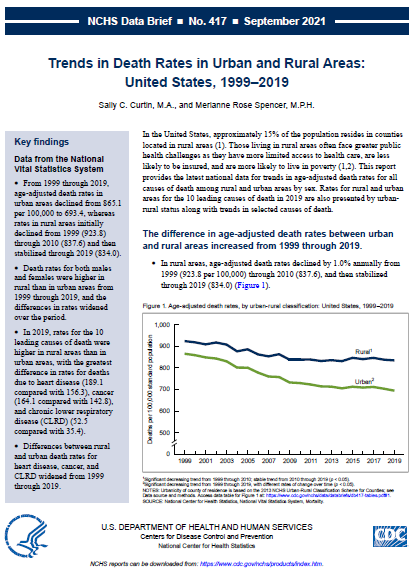Q & A: Trends in Death Rates in Urban and Rural Areas: United States, 1999–2019
Posted on by
Questions for Sally Curtin, Health Statistician and Lead Author of “Trends in Death Rates in Urban and Rural Areas: United States, 1999–2019.”
Q: Why did you decide to do a report comparing death rates in rural and urban areas?
SC: In many of our reports, we have examined trends in various causes of death by urban-rural status. However, we had not published data on trends in all-cause mortality by urban-rural status. In addition, we had not analyzed death rates for all of the 10 leading causes of death by urban-rural status in one report. Thus, we felt that a report showing national statistics on urban-rural disparities by leading causes of death might be informative to those interested in delving more into these findings at a state or local level.
Q: How does the data vary by leading causes of death?
SC: The data in this report present a compelling picture of rural health as the age-adjusted rates for all 10 leading causes of death were higher in rural than urban areas. In addition, we show that the differences between rates in rural and urban areas were greatest for the top causes of heart disease, cancer and chronic lower respiratory diseases and the gap widened over the 1999-to-2019 period.
Q: What is the take home message in this report
SC: The gap in mortality between rural and urban areas has widened over the last 20 years with the overall age-adjusted rate in rural areas increasing from 7% higher than in urban areas in 1999 to 20% higher by 2019. In addition, higher death rates in rural than urban areas were evident for all 10 leading causes of death with the greatest differences for some of the top causes: heart disease, cancer, and chronic lower respiratory diseases.
Q: Do you have any predictions to how 2020 death rates will look for urban/rural areas will look?
SC: We (NCHS) are not into forecasting so I will not speculate, but I can tell you that a report on COVID-19 deaths by urban-rural status for 2020 is planned.
Q: Any other comments?
SC: In the introduction of the report, we point out that there are health challenges that are greater in rural than urban areas such as more limited access to health care, less health insurance, and more poverty. Hopefully the findings in this report will alert the research community, health practitioners, and the public that the mortality disparity between rural and urban areas is widening and cannot be pinpointed to just a few causes of death but extends to all 10 leading causes.
Posted on by

